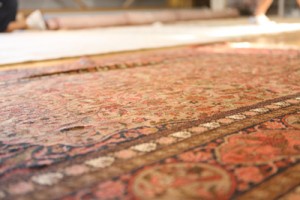White Knots in Oriental Rugs
Is my Oriental rug flawed?
Rug cleaning and repair customers often ask about perceived imperfections in their Oriental rugs. However, some of these imperfections are natural in hand knotted rugs, especially in tribal and village rather than factory made ones. Many Oriental rug collectors and connoisseurs do not see these supposed imperfections as flaws but rather as characteristics of unique hand made works of art and beauty.

What are the little white specks throughout my rug?
When rugs are initially constructed, weavers tie strings together to form long, vertical warp threads from the top beam of their loom to the bottom beam. The white specks throughout a rug’s pile are the edges of the tied warp strings and are called white knots. These knots are present in most Oriental rugs but are usually invisible within the thick pile of a new rug. For example, a 90 line Chinese rug has roughly 56 knots per square inch. This makes for a very dense, luxurious and heavy pile that can easily conceal the knots located closer to the base of the rug. However, over many years of regular vacuuming and foot traffic, the pile wears and becomes thinner. It is then that white knots become apparent.
Why did the white knots become visible after professional rug cleaning?
The thick, lush piles of handmade Oriental rugs effectively hide white knots. However, sometimes the knots become exposed after washing, which is especially true with dark pile rugs. This is due to the normal day-to-day soiling that accumulates and covers up white knots, blending them into the pile. A thorough rug cleaning removes the dust and grime, revealing the white knots. This is not a defect in the rug, nor is it incompetence on the part of the rug cleaners. It is, however, a typical characteristic of lovely, hand made Oriental rug construction.
How can white knots be removed?
There are several ways to take care of white knots and make them less obvious. However, they are not all equally effective. The trimming method is productive and methodical, yet it is slow. The process requires an experienced rug repair technician to clip off the uncut ends of the white knots in the warp strings using small scissors or sharp clippers. The knots will remain in the pile of the rug, but they will not be visible if the pile is reasonably thick. This trimming technique is not damaging to the construction of the rug and will achieve the desired results. However, because the process is precise and time consuming, it may be more expensive than the alternatives.
Equally effective to the trimming technique, is a process where the white knots are pushed through to the back of the rug with a pointed tool. This technique is also time consuming and may be pricey, as it requires a skilled technician to perform a meticulous task. This option yields long lasting results.
Another method employed by some rug repair shops is a quick fix option of dyeing the knots to match the surrounding design of the rug. However, this is not a lasting solution, as the dye will fade once the rug is washed. Moreover, if the pile of the rug is thin and sparse, the base of the white knot will be visible even if dyed.
The technique used to eliminate the appearance of white knots depends on several factors. Cost is certainly one consideration. However, another consideration is the fragility of the rug. When customers discuss options with their local rug repair shop, the overall condition of the rug needs to be evaluated. If the rug is old or fragile and has a thin pile, customers may choose to just enjoy it the way it is. After all, white knots are part of the distinguishing uniqueness of hand made rugs.







